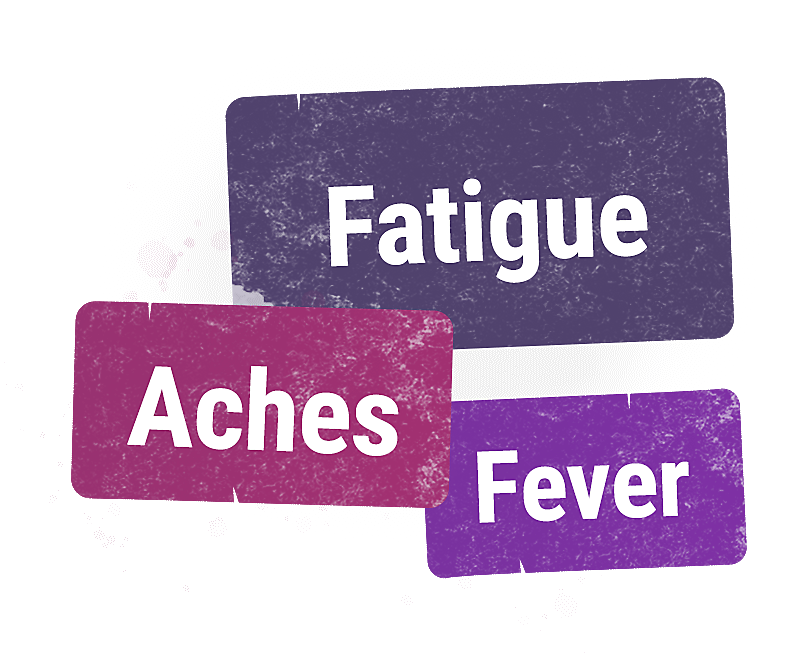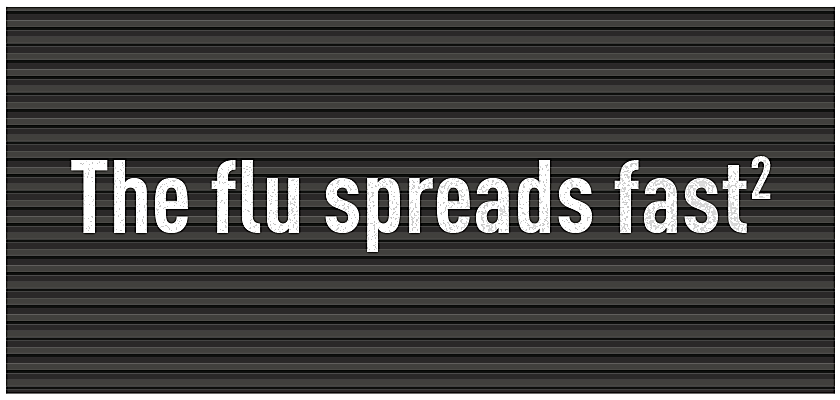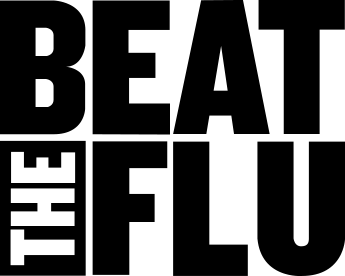What is the flu?
The flu is a respiratory illness caused by a virus.1,2
Like COVID-19 is caused by a ‘coronavirus’,3
the flu is caused by the ‘influenza’ virus.1,2

The flu causes a range of different symptoms that leave people feeling very unwell including fatigue, aches and fever.2,4
Find out how symptoms of the flu differ from those of COVID-19 and the common cold

How many people does the flu affect?
Globally, up to 1 billion cases of the flu can occur each year.5
Up to 5 million of these cases are deemed severe...
...resulting in up to 650,000 deaths.6


The flu spreads in a similar way to COVID-19.7–10
Infectious virus particles are released when an infected person coughs, sneezes or talks.8–10
These can land on, or get inhaled by, someone else.9,10
Flu particles can even live on surfaces for up to 48 hours.11
Most people can spread the flu virus before they even develop symptoms and continue to infect others for up to 7 days after symptoms appear.9
Did you know?
An infected person can spread the flu to people as far as 6 feet away.9
Because of the similarities between the spread of the flu and COVID-19, public health measures such as good hand hygiene can help prevent the viruses from spreading.7
But these measures alone are rarely enough.
How serious is the flu?
Many people see the flu as a minor illness with little threat of serious consequences.12–14 But it can cause a wide range of severe, and in some cases, life-threatening complications. These include:4


In the USA, up to 960,000 people are hospitalised with the flu each year, resulting in up to 79,000 deaths.15
The rates of hospitalisations and deaths are thought to be similar across several Asia-Pacific countries and temperate regions, like Europe.16
Many individuals and their loved ones are at high risk of developing serious complications, which is why we must act fast to beat the flu.17
References
- Centers for Disease Control and Prevention (CDC). Understanding influenza viruses. Available from: https://www.cdc.gov/flu/about/viruses/index.htm. Last accessed: October 2020.
- Banning M. Br J Nurs 2005; 14(22): 1192–1197.
- World Health Organization. Coronavirus. Available from: https://www.who.int/health-topics/coronavirus#tab=tab_1. Last accessed: October 2020..
- Centers for Disease Control and Prevention (CDC). Flu symptoms and complications. Available from: https://www.cdc.gov/flu/symptoms/symptoms.htm. Last accessed: October 2020.
- Krammer F et al. Nat Rev Dis Primers 2018; 4(1): 3.
- World Health Organization (WHO). Influenza (Seasonal). Available from: www.who.int/news-room/fact-sheets/detail/influenza-(seasonal). Last accessed: October 2020.
- World Health Organization (WHO). Q&A: Similarities and differences – COVID-19 and influenza. Available from: https://www.who.int/news-room/q-a-detail/q-a-similarities-and-differences-covid-19-and-influenza. Last accessed: October 2020.
- Centers for Disease Control and Prevention. How flu spreads. Available from: https://www.cdc.gov/flu/about/disease/spread.htm. Last accessed: October 2020.
- Centers for Disease Control and Prevention. Estimated Influenza Illnesses, Medical visits, Hospitalizations, and Deaths in the United States — 2017–2018 influenza season. Available from: www.cdc.gov/flu/about/burden/2017-2018.htm. Last accessed: November 2019.
- Centers for Disease Control and Prevention (CDC). Frequently asked questions: How does the virus spread? Available from: https://www.cdc.gov/coronavirus/2019-ncov/faq.html. Last accessed: October 2020.
- Centers for Disease Control and Prevention. Environmental NPIs: Surface Cleaning. Available from: https://www.cdc.gov/nonpharmaceutical-interventions/environmental/index.html. Last accessed: October 2020.
- Evans MR et al. Br J Gen Pract 2007; 57: 352–358.
- Cedraschi C et al. BMC Fam Pract 2013; 14: 15.
- Nowak G et al. Int J Environ Res Public Health 2018; 15(4): 711.
- Centers for Disease Control and Prevention. Estimated Influenza Illnesses, Medical visits, Hospitalizations, and Deaths in the United States — 2017–2018 influenza season. Available from: www.cdc.gov/flu/about/burden/2017-2018.htm. Last accessed: October 2020.
- Cowling B et al. Vaccine 2017; 35: 856–864.
- Centers for Disease Control and Prevention (CDC). People at High Risk of Developing Serious Flu-Related Complications. Available from: www.cdc.gov/flu/about/disease/high_risk.htm. Last accessed: October 2020.
